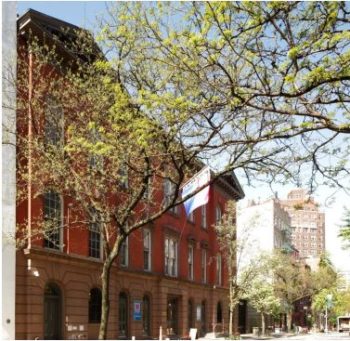
The Lesbian, Gay, Bisexual & Transgender Community Center. Image Credit: NYC LPC
The six buildings are up for consideration in honor of the 50th anniversary of the Stonewall Riots. On May 14, 2019, the Landmarks Preservation Commission held a calendaring hearing for five buildings in Manhattan and one building in Staten Island to consider for future designation. The six sites – the Gay Activists Alliance Firehouse, Women’s Liberation Center, the Lesbian, Gay, Bisexual & Transgender Community Center, the Caffe Cino, the James Baldwin Residence and the Audre Lorde Residence – all reflect some aspect of New York’s LGBT history.
In recognition of the 50th Anniversary of the Stonewall Riots, the Landmarks Preservation Commission searched for individual landmarks throughout the city that could be landmarked before or during June, which is also Pride Month.
The Gay Activists Alliance Firehouse
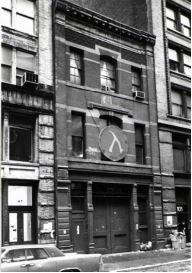
The Gay Activist Alliance Firehouse in 1973, featuring a shield with the lambda symbol. Image Credit: NYC LPC
The Gay Activists Alliance Firehouse was at 99 Wooster Street between Spring and Prince Streets in the SoHo-Cast Iron Historic District. The building was a former firehouse redesigned in the Neo-Grec style in 1881 – 1882 by Napoleon Le Brun. The firehouse is three stories tall with a cast iron base and red brick with stone trim and terracotta detailing on the second and third stories.
The building served as the headquarters for the Gay Activists Alliance (GAA) from 1971 until 1974. The GAA lobbied for LGBT civil rights. Their headquarters served as New York City’s “first gay community center” and served as a meeting space for growing organizations and groups like the Gay Men’s Health Project, Lesbian Feminist Liberation, and the Catholic group Dignity. Cultural programming was also held at the firehouse. The GAA produced weekly cable television programming and a newssheet entitled “Gay Activist.” The GAA was the first group to adopt the lambda as a symbol for LGBT rights.
Women’s Liberation Center
The Women’s Liberation Center was at 243 West 20th Street between 7th and 8th Avenues in Chelsea. The building was a former firehouse built in 1866 by Charles E. Hartshorn.
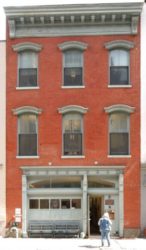
243 West 20th Street, the former home of the Women’s Liberation Center, as it is today. Image Credit: NYC LPC
The Women’s Liberation Center was a volunteer-run collective of feminist social service groups, women’s political committees, and lesbian organizations. Lesbian Feminist Liberation branched off from the Gay Activists Alliance in 1972 and began holding meetings at the Women’s Liberation Center. The group fought against lesbian discrimination and advocated for women’s visibility at LGBT rallies and for lesbian mothers. The Women’s Liberation center also housed the Lesbian Switchboard, a volunteer telephone service for peer counseling, referrals and information about local events, providing critical mental health support and community. Other groups that frequented the Women’s Liberation center included the Lesbian Lifespace Project, the Radicalesbians Health Collective, the Radical Feminists, and Older Women’s Liberation. There was also a wholesale food-buying cooperative on the ground floor called the Lesbian Food Conspiracy.
The Women’s Liberation Center disbanded in 1987. Many of its organizations moved to the Lesbian, Gay, Bisexual & Transgender Community Center.
Today, the building houses Non-Traditional Employment for Women, a skilled-trades workforce development program.
The Lesbian, Gay, Bisexual & Transgender Community Center
The Lesbian, Gay, Bisexual & Transgender Community Center is located at 208 West 13th Street between Seventh and Eighth Avenues in the Greenwich Village Historic District. The building is a former school building originally constructed in 1869 and with additions finished in 1879 and 1887. The original building was constructed by Ammon Macvey, Superintendent of Public School Buildings, and the additions were constructed by Thomas R. Jackson and William H. Wilcox. The building is three stories tall and made in the Italianate style. The Center has done facade restorations and interior renovations over the three decades it has occupied the building.
The Lesbian, Gay, Bisexual & Transgender Community Center has been a communal space for the LGBT community for over 35 years. The original center was occupied by six tenant organizations in 1984, including S.A.G.E., Partnership for the Homeless, Metropolitan Community Church and the Community Health Project, which was the nation’s first community-based HIV clinic. Throughout its history, the Center has partnered with various groups and organizations to educate and advocate for LGBT rights.
The building was used as a meeting space for the Coalition for Lesbian and Gay Rights in the 1980s and played a major role in the passage of the 1986 ban on discrimination against sexual orientation. Other groups that have met at the Center include Gay and Lesbian Youth, the Lesbian Switchboard, Dignity/New York, Asian Lesbians of the East Coast, Harvey Milk High School, Salsa Soul Sisters, Survivors of Transsexuality Anonymous, and the Gender Identity Project.
Today, the Center continues to provide services and programming to New York’s LGBT community.
Caffe Cino
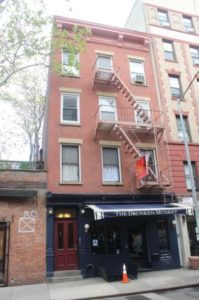
31 Cornelia Street was the former site of Caffe Cino. Image Credit: NYC LPC
The Caffe Cino was once located at 31 Cornelia Street, between Bleecker and West 4th Streets in the Greenwich Village Historic District Extension II. The building at 31 Cornelia Street is a four-story Italianate building built by Benjamin Warner in 1877. The building has a stone foundation and Philadelphia brick walls that feature cast iron and wood storefront elements. A restaurant currently occupies the ground floor retail space.
Joe Cino was an Italian-American gay man who opened the Caffe Cino in 1958. The café was originally a coffee shop and art exhibition space but soon it was also used for poetry readings and small experimental theater. The café quickly became a venue for unknown playwrights to showcase their work. Most of these playwrights were gay men, and the Caffe Cino became their venue because it was illegal to portray homosexuality in theatrical productions. New York’s “Off-Off-Broadway” scene was created here, and many projects expressly depicted homosexual themes on stage. Performances at the Caffe Cino usually only required a one-dollar purchase at the café to attend, which also made the venue accessible.
Many significant playwrights got their start at Caffe Cino, like Tom Eyen, writer of Broadway hit Dreamgirls (1981); John Guare, author of Six Degrees of Separation; Pulitzer Prize-winning playwright and actor Sam Shepard and Lanford Wilson, who wrote the Broadway hit Fifth of July.
Tragically, Joe Cino committed suicide in 1968, after which the Caffe Cino closed.
James Baldwin Residence
The James Baldwin Residence is located at 137 West 71st Street in the Upper West Side/Central Park West Historic District. The converted row house was originally constructed in 1890 and redesigned in the modern style by H. Russell Kenyon in 1961. The facade was brought forward to align with the buildings next door. The modern style is reflected in the white brick facade, picture windows, asymmetric fenestration.
Writer and activist James Baldwin purchased 137 West 71st Street for himself and his family in 1965. Baldwin is known for works like Go Tell It on the Mountain (1953), Notes of a Native Son (1955) and Nobody Knows My Name (1963). His writings, featuring critiques of American race relations, established him as a leader of the early civil rights movement. His fiction depicting bisexual and same-sex relationships, found in works like Giovanni’s Room (1956) and Just Above My Head (1979), was considered groundbreaking at the time.
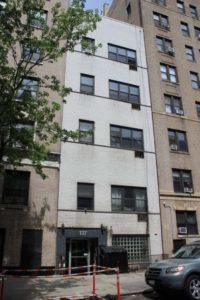
James Baldwin Residence at 137 West 71st Street. Image Credit: NYC LPC
Baldwin participated in several notable New York City events, including an appearance with Dr. Martin Luther King, Jr. at Carnegie Hall in 1968 and a 1982 meeting of Black and White men Together, where he spoke publicly about being a gay African-American man.
Baldwin frequently traveled between New York and France, but always kept an apartment at 137 West 71st Street. Baldwin’s niece Aisha Karefa-Smart stated in 2013 that whenever Baldwin returned to the building, “the energy, and vitality at 137 elevated to a fever pitch as soon as he hit the door. Even before he arrived, the house was ablaze with excitement and anticipation just by the mention of his name.” Many major writers and jazz musicians frequented the building to visit with Baldwin and his family, including Amiri Baraka, Miles Davis, Dizzy Gillespie, and Max Roach. Toni Morrison briefly lived in the building as well.
Audre Lorde Residence
The Audre Lorde Residence is located at 207 St. Paul’s Avenue in the St. Paul’s Avenue-Stapleton Heights Historic District in Staten Island. The building is a detached Neo-Colonial house built in 1898 by Otto Loeffler. The house has a gabled roofline and an open porch with turned columns and a pediment featuring a sunburst decoration.
From 1972 to 1987, the house was the home of Audre Lorde, a renowned African-American and lesbian writer. Lorde was born in New York City in 1934 and attended Hunter College and Columbia University. She later became an English professor at Hunter and John Jay Colleges.
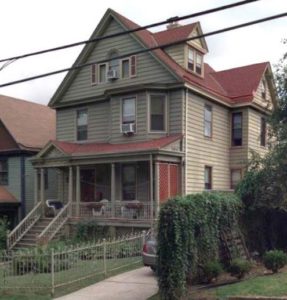
Audre Lorde Residence, 207 St. Paul’s Avenue, SI. Image Credit: NYC LPC
Many of Lorde’s most influential works were written while she resided at 207 St. Paul’s Avenue. Her third volume of poetry, From a Land Where Other People Live was nominated for a National Book Award in 1973. During her residence here, she also wrote notable works like Coal (1976), The Black Unicorn (1978), The Cancer Journals (1980), and Zami: A New Spelling of My Name (1982).
Lorde was also known for her political activism for African-American civil rights, feminism, and gay and lesbian civil rights. She spoke at the National March on Washington for Lesbian and Gay Rights in 1979. In 1980, she co-founded Kitchen Table: Women of Color Press, which was a publisher dedicated to work by and for women of color.
In 1991, Lorde was appointed as the Poet Laureate for New York State. She passed away in November 1992.
The Landmarks Preservation Commission unanimously voted to calendar all six of these buildings for consideration. There will be a public hearing for these buildings on June 4, 2019.
By: Veronica Rose (Veronica is the CityLaw Fellow and a New York Law School Graduate, Class of 2018.)

